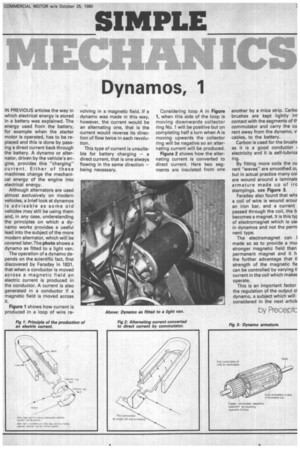Dynamos, 1
Page 79

If you've noticed an error in this article please click here to report it so we can fix it.
IN PREVIOUS articles the way in which electrical energy is stored in a battery was explained. The energy used from the battery, for example when the starter motor is operated, has to be replaced and this is done by passing a direct current back through the battery. A dynamo or alternator, driven by the vehicle's engine, provides this "charging" current. Either of these machines change the mechanical energy of the engine into electrical energy.
Although alternators are used almost exclusively on modern vehicles, a brief look at dynamos is advisable as some old vehicles may still be using them and, in any case, understanding the principles on which a dynamo works provides a useful lead into the subject of the more modern alternator, which will be covered later. The photo shows a dynamo as fitted to a light van.
The operation of a dynamo depends on the scientific fact, first discovered by Faraday in 1831, that when a conductor is moved across a magnetic field an electric current is produced in the conductor. A current is also generated in a conductor if a magnetic field is moved across it.
Figure 1 shows how current is produced in a loop of wire re
volving in a magnetic field. If a dynamo was made in this way, however, the current would be an alternating one, that is the current would reverse its direction of flow twice in each revolution.
This type of current is unsuitable for battery charging — a direct current, that is one always flowing in the same direction — being necessary.
Considering loop A in Figure 1, when this side of the loop is moving downwards collector ring No. 1 will be positive but on completing half a turn when A is moving upwards the collector ring will be negative so an alternating current will be produced.
Figure 2 shows how the alternating current is converted to direct current. Here two segments are insulated from one
another by a mica strip. Carbo brushes are kept lightly ml
contact with the segments of ti' commutator and carry the cu rent away from the dynamo, v cables, to the battery. Carbon is used for the brushE as it is a good conductor 4 electricity and it is self-lubrica ing.
By fitting more coils the cu rent "waves" are smoothed CL but in actual practice many coi are wound around a laminat€ armature made up of ire stampings, see Figure 3.
Faraday also found that whE a coil of wire is wound arour an iron bar, and a current passed through the coil, the b becomes a magnet. It is this tyj of electromagnet which is us( in dynamos and not the perm nent type.
The electromagnet can I made so as to provide a mui stronger magnetic field than permanent magnet and it h the further advantage that tl strength of the magnetic fie can be controlled by varying tl current in the coil which makeE operate.
This is an important factor the regulation of the output oi dynamo, a subject which will considered in the next artick
by Preceot
























































































































































